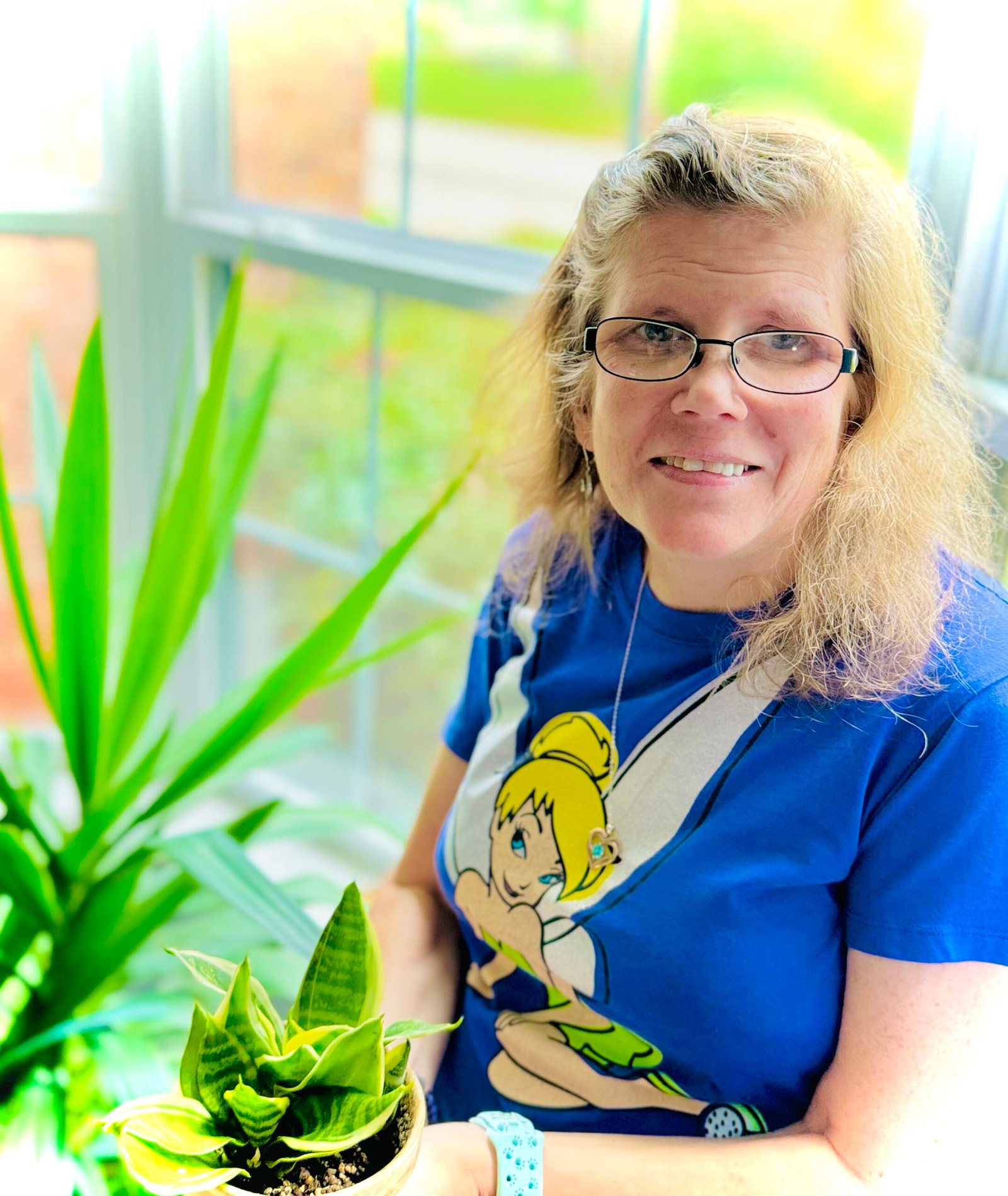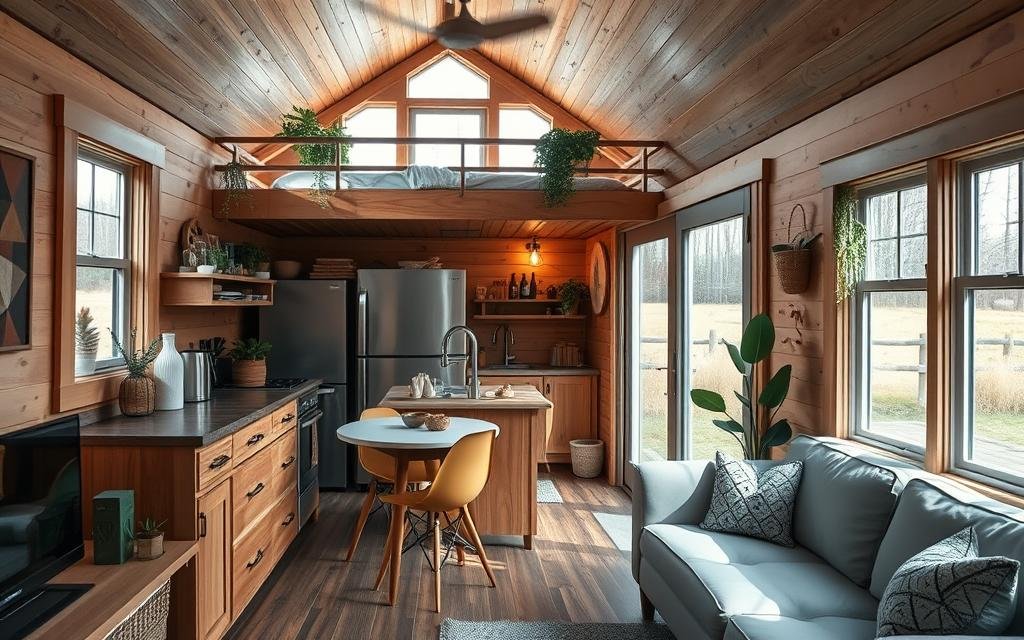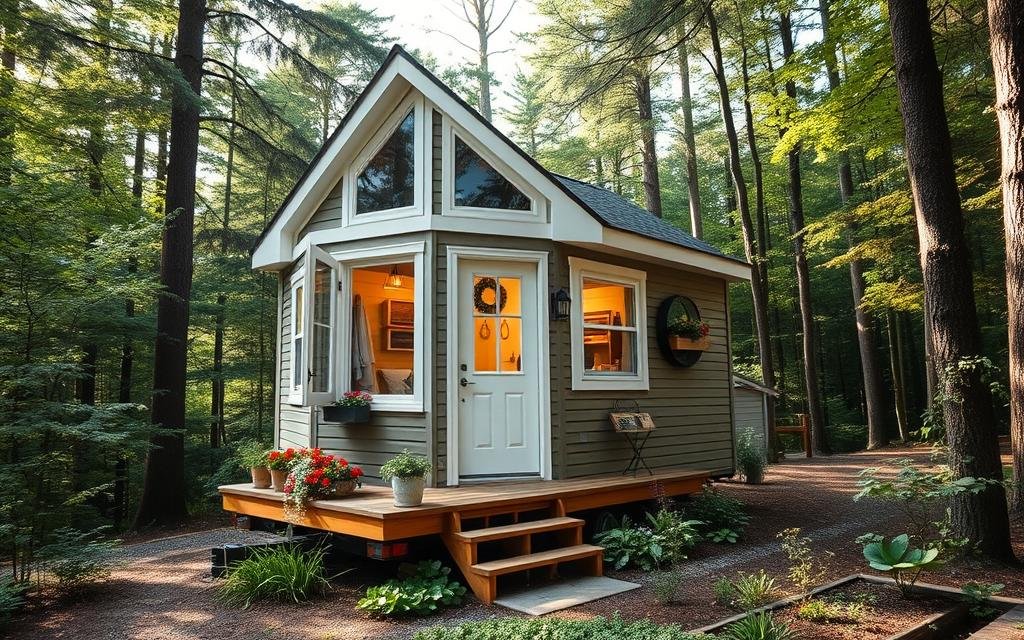Tiny home living has won the hearts of many who want a simple life. These small homes, usually between 100 and 400 square feet, are a big change from big houses1. If you’re thinking about downsizing, it’s key to know all about tiny houses.
The tiny house movement is growing fast, with more people wanting custom and small designs. But, buying a tiny home comes with its own set of challenges. Buyers often face surprises like budget problems and limited space2.
On average, a tiny home costs about $45,000, but prices can go from $30,000 to $70,0001. It’s important to think about extra costs when planning your budget. Many tiny house projects end up costing more than expected, so careful planning is key3.
Before you buy, try renting a tiny house to see if it’s right for you. This can help you figure out what you need in a small space. Remember, summer is a great time to move into a tiny home because of the weather and community vibes1.
Key Takeaways
- Tiny houses range from 100 to 400 square feet
- Average cost is around $45,000, but can vary significantly
- Budget for potential cost overruns and hidden expenses
- Consider renting before buying to test the lifestyle
- Summer is the best time to move into a tiny home
- Careful planning is essential for successful tiny living
Understanding the Tiny House Movement
The tiny house movement is a big deal today. It’s a response to tough times and a wish for simpler living. It’s changed how we see homes, moving towards sustainable and small living spaces.
Origins and Growth of Tiny Living
Tiny homes are smaller than 40 square meters. They’ve become popular since the financial crisis4. These small homes, often under 600 square feet, offer a fresh way to live5.
More builders are making these small homes because of growing interest6.
Benefits of Downsizing
Living tiny has many perks. Homeowners often don’t have to worry about mortgages because of lower costs6. These homes are good for the planet and can save you money on energy45.
They also encourage a simpler way of life. This means focusing on what’s really important and using less4.
Types of Tiny Houses Available
Tiny houses come in many styles to meet different needs:
| Type | Description | Key Feature |
|---|---|---|
| Tiny House on Wheels (THOW) | Built on trailers for mobility | Popular choice for flexible living |
| Foundation-based Tiny Houses | Permanent structures on fixed foundations | More stability and traditional feel |
| Converted Vehicles | Repurposed buses, vans, or RVs | Combines tiny living with travel |
| Off-grid Tiny Houses | Self-sufficient homes with sustainable systems | Ideal for remote or eco-conscious living |
Despite challenges like finding a place to park, getting financing, and dealing with insurance5, the tiny house movement keeps growing. It offers a special way to live affordably and sustainably.
What to Know Before Buying a Tiny House
Starting a tiny house project needs careful planning. The tiny home market is full of opportunities, but it’s important to know the details first. Let’s look at key things to remember as you begin this exciting journey.
When making your tiny house plans, budget is key. Prices can range from $20,000 to $100,000, based on what you want and the materials used. Tiny homes cost more per square foot than regular houses, about $400 compared to $1507.
Financing for tiny house projects varies. If you’re not paying cash, expect to put down 20% to 25%. For cash, builders might ask for 60% upfront and 40% when it’s done8. You can also look into builder financing, online lenders, personal loans, and RV loans7.
Think about the build time when planning. Trailers take five weeks to make, then 6-12 weeks for the house itself. This time can change8. Also, remember delivery costs, which are about $2 per mile8.
Zoning laws and safety standards are very important. Many places have rules against living full-time in temporary homes. Make sure your plans meet safety rules, like ceiling heights and emergency exits7.
Living in a tiny house community has its perks, but it also has challenges. You’ll need to plan carefully for storage and air. Hosting events can be hard, and bad weather can be a risk, especially without a permanent foundation7. Knowing these things will help you start your tiny house journey better.
Defining Your Tiny House Goals
Starting your tiny home journey means setting clear goals. Tiny houses are usually between 100 to 500 square feet, with most being 100 to 400 square feet9. You’ll need to plan carefully to fit your lifestyle into this small space.
Assessing Your Lifestyle Needs
Think about how a tiny home fits into your daily life and future plans. Living small often means owning fewer things and living more simply10. Consider your work, hobbies, and family size when designing your tiny home.
Determining Your Budget
Tiny homes are a budget-friendly choice, costing between $29,000 to $250,0009. This is much less than the average $400,000 for a traditional home in 20249. Make sure to include extra costs like permits, which can range from a few hundred to thousands of dollars9.
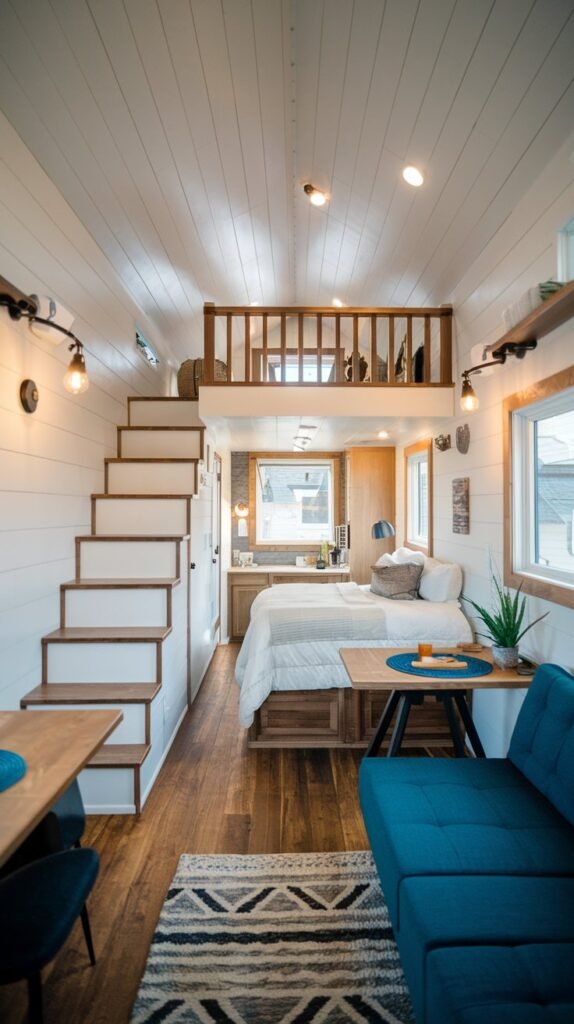
Choosing Between Mobile and Stationary Options
Deciding between a mobile or stationary tiny home is a big choice. Building on a foundation costs $7,000 to $10,000 plus land, while a trailer for a mobile home is $5,500 to $9,5009. Think about whether you want to travel or stay put.
| Tiny Home Size (sq ft) | Average Cost | Price Range |
|---|---|---|
| 100 | $29,000 | $19,000 – $45,000 |
| 200 | $58,000 | $35,000 – $85,000 |
| 300 | $87,000 | $50,000 – $130,000 |
| 400 | $112,000 | $70,000 – $170,000 |
| 500 | $172,000 | $100,000 – $250,000 |
By setting clear goals, you’ll be ready to choose the right tiny home lifestyle for you and your budget.
Legal Considerations for Tiny Houses
Understanding the legal side of tiny homes can be complex. Zoning laws and building codes differ across the U.S., affecting permits and property rules. It’s essential to grasp these legal aspects before starting your tiny home adventure.
The size of tiny homes is a significant factor in many places. Homes usually range from 100 to 400 square feet, but local rules often set minimum sizes11. This can be a big challenge for tiny home fans. However, some places are becoming more welcoming to tiny homes. For example, Walsenburg, Colorado, was the first city to allow tiny homes on residential lots in 201411.
Zoning laws are also crucial. Many places have rules on where you can park or build your tiny home. Some view tiny houses on wheels as RVs, while others require them to be on foundations12. For instance, in Anchorage, Alaska, tiny houses on wheels are treated as RVs, but those on foundations need a special permit12.

Getting utility connections can also be tough for tiny home owners11. You’ll need to look into local rules for water, electricity, and sewage. Some places require public utilities, while others allow off-grid options.
Financing tiny homes can be tricky too. About 68% of owners pay cash13. If you’re looking for a loan, know that Fannie Mae wants homes to be at least 600 square feet, and the FHA requires 400 square feet13.
| State | Tiny Home Regulations |
|---|---|
| California | Very friendly; most cities allow tiny homes as ADUs |
| Colorado | Walsenburg waived minimum square footage for tiny homes |
| Alabama | Jefferson County permits ADUs up to 200 square feet |
| Arkansas | Varies by city; some restrict homes to 600+ square feet |
Remember, laws can change quickly in the tiny home world. Always check with local authorities about current permits, zoning, and property rules before making any decisions.
Financing Options for Tiny Homes
Getting a loan for a tiny home can be challenging. But, there are many ways to fund your dream of living small. We’ll look at different financing options to help you stay within your budget.
Personal Loans and RV Loans
Personal loans are a common choice for tiny homes. They have APRs from 3% to 36% and can be repaid in up to 7 years. This flexibility is great for your tiny home budget14. RV loans, on the other hand, are for mobile tiny homes. They often have longer repayment terms and might need a down payment14.
Tiny House-Specific Financing
Some builders offer loans just for tiny homes. These loans have terms similar to RV loans. Interest rates are usually between 4.5% to 7.5%, and you can repay them in up to 20 years15. This makes building a tiny home more affordable for many.
Home Equity Loans for Current Homeowners
If you own a home, using your equity can be a smart move. This option often has lower interest rates than personal loans. It could save you money over time.
| Financing Option | Interest Rate Range | Typical Loan Term |
|---|---|---|
| Personal Loan | 3% – 36% | Up to 7 years |
| RV Loan | 4.5% – 7.5% | Up to 20 years |
| Builder Financing | Varies | Similar to RV loans |
| Home Equity Loan | Varies (typically lower) | 5 – 30 years |
Remember, tiny homes usually cost between $30,000 to $60,000. This might be less than what traditional mortgages require1415. Your credit score is important. It affects the interest rates and terms you get for your tiny home loan.
Designing Your Tiny House Layout
Creating a functional tiny house floor plan needs careful planning. Every inch matters in your compact home design. Tiny houses are usually 400 square feet or less, so efficiency is crucial16.
Begin by thinking about your lifestyle needs and what’s essential. The post-it exercise helps figure out space needs and what’s important, unnecessary, or can be outsourced17. This ensures your tiny home meets all your living needs.
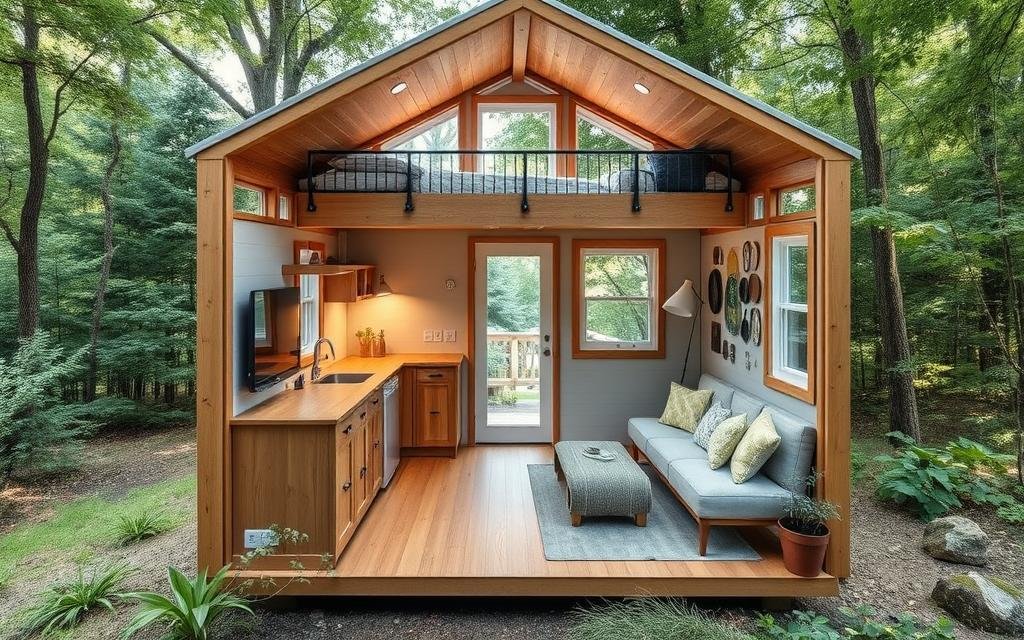
When designing your small space, focus on multi-purpose areas and vertical storage. Fold-down furniture and loft beds are key to saving space16. Open floor plans are also popular to avoid partitions and make the space feel larger.
Consider these elements for an efficient tiny house layout:
- Vertical design to create an illusion of a larger home
- Storage solutions below waist level to maintain open space
- Compact kitchen design with space-saving appliances
- Loft access: stairs or ladders (impacts space utilization)
Low-fidelity testing, like building cardboard prototypes, lets you quickly assess and improve design ideas17. Take time to think through each decision to avoid costly mistakes. This ensures your tiny home perfectly fits your lifestyle.
| Design Element | Purpose | Benefits |
|---|---|---|
| Fold-down furniture | Space-saving | Versatile living areas |
| Vertical storage | Maximize space | Illusion of larger home |
| Open floor plan | Avoid partitions | Sense of spaciousness |
| Loft bed | Save floor space | Separate sleeping area |
Essential Features and Amenities
When designing your tiny house, focus on maximizing space and functionality. Tiny houses are usually small, so every inch counts18.
Space-saving furniture and storage solutions
Built-in furniture is key in tiny homes. Choose items like Murphy beds and fold-down tables. Also, use under-stair spaces for extra storage.
These smart solutions help you use your space well. They keep your tiny house tidy and organized.
Efficient appliances for tiny living
Go for compact, energy-saving appliances. A mini-fridge and a two-burner stove fit well in small kitchens. A tankless water heater saves space and energy too.
The right appliances can lower your bills. They also make living in a tiny house more enjoyable.
Off-grid systems and sustainability options
Choose off-grid systems for a greener home. Solar panels and rainwater collection systems are good choices. They help you live more sustainably and save money in the long run.
| Feature | Benefits | Considerations |
|---|---|---|
| Built-in furniture | Space-saving, customizable | Initial cost, permanence |
| Compact appliances | Energy-efficient, space-saving | Limited capacity, potentially higher cost |
| Off-grid systems | Sustainability, independence | Initial investment, maintenance |
By picking the right features, you can make a cozy tiny house. It can support your lifestyle, even if you work from home. Remember, the cost of a tiny house depends on design and materials18.
Choosing a Tiny House Builder or DIY Approach

When you buy a tiny home, you must decide: go with a professional builder or do it yourself. Each choice has its own benefits and drawbacks. Professional builders are experts in tricky tasks like plumbing and wiring, which can be hard for DIYers19.
Choosing DIY means you’ll spend a lot of time on your project. DIYers often take about 2 ½ years to finish their tiny homes. Some projects can take up to 7 years19. This way, you can make your home exactly how you want it, but it takes a lot of skill and effort.
When picking a builder, do your homework. Look for builders with good reputations and happy customers. Avoid new builders, as they might not deliver quality or on time20. Ask about certifications like RVIA, which means your home is safe and ready for the road19.
Think about your budget too. Tiny homes can cost from $10,000 for a simple DIY to $200,000 for a fancy custom home21. If you’re good with your hands, using old materials and doing some work yourself can save money21. Don’t forget to plan for ongoing costs like utilities, which can be about $35 a month for electricity in a mobile tiny house21.
No matter your choice, make sure your tiny home follows local rules. Joining a tiny house community can also help with support and shared spaces21. With the right planning, your tiny house dream can come true.
Finding Land and Parking for Your Tiny House
Finding a spot for your tiny house is key to your new lifestyle. Tiny houses, usually under 400 square feet, need careful thought when choosing a location22. Let’s look at your options and what to think about while searching.
Zoning Laws and Regulations
Building codes and zoning rules change a lot by state. They can really affect where you can put your tiny house22. Before you decide, call your local zoning office to learn the rules. This is important whether you’re buying land or parking in a community.
Tiny House Communities and RV Parks
Many tiny house fans live in special communities or RV parks. These places offer amenities and a community feel. When looking at RV parks, check their rules on vehicles and what’s available23. Some parks might have rules on how you can transport your tiny house or specific trailer needs.
Purchasing Land vs. Renting Space
Buying land gives you stability but comes with extra duties. Think about property taxes, insurance, and getting utilities23. Renting or leasing land might be more flexible, but make sure you know the agreement details, like any rules on making changes or how long you can stay23.
When looking for land, talk to other tiny house owners and use online sites like social media and Craigslist22. Find a place that fits your budget, wants, and lifestyle. Also, remember to think about the cost of getting the land ready for your tiny house, which can be a big expense22.
Whether you buy or rent, make sure your tiny house fits the space and local rules. With good planning, you’ll find the ideal spot for your tiny home and start your new life.
Hidden Costs of Tiny House Ownership
Exploring the tiny house lifestyle can reveal unexpected expenses. The average tiny house costs between $30,000 and $40,000. However, building one might cost around $65,000, with materials alone reaching $25,00024. Material costs can rise due to supply chain issues and inflation25.
Your tiny home’s size, usually between 100 and 500 square feet, might need custom appliances. These specialized items can quickly increase your expenses. You might also need to rent storage for items that don’t fit in your new home25.
Zoning laws can lead to unexpected costs. Not following these laws might result in fines or require you to move your tiny house25. Insurance costs can vary, depending on the builder’s certification and whether your home is on a trailer or foundation24. Remember, tiny houses might depreciate over time due to limited resale markets and customization2524. Knowing these hidden costs will help you prepare for your tiny living journey.
